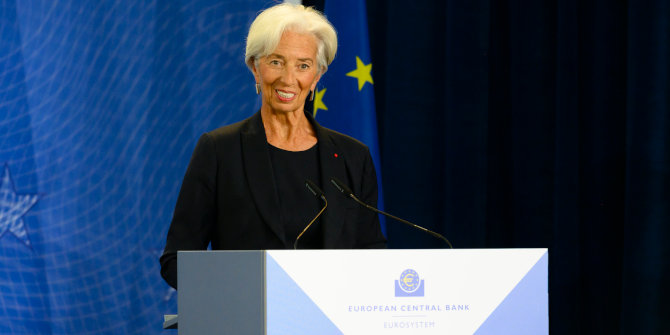 On 10 March, EU finance ministers agreed to roll out Jean-Claude Juncker’s flagship investment programme, commonly termed the ‘Juncker plan’. Harald Sander writes on the economic impact the plan could have in the Eurozone. He argues that while it has been portrayed by some observers as a route to helping the Eurozone’s recovery, it will require far more than the Juncker plan to stimulate growth in Europe’s ailing economies.
On 10 March, EU finance ministers agreed to roll out Jean-Claude Juncker’s flagship investment programme, commonly termed the ‘Juncker plan’. Harald Sander writes on the economic impact the plan could have in the Eurozone. He argues that while it has been portrayed by some observers as a route to helping the Eurozone’s recovery, it will require far more than the Juncker plan to stimulate growth in Europe’s ailing economies.
The €315 billion European investment initiative – the so called ‘Juncker plan’ – was accepted by EU finance ministers on 10 March and is expected to go operational as a new “European Fund for Strategic Investment” (EFSI) by mid-2015. Is this finally good news for Eurozone recovery? Unfortunately, the Juncker plan has been widely misunderstood as a recovery programme for the crisis-ridden Eurozone: it is in fact no more and no less than a (welcome) investment initiative for Europe.
The Juncker plan is not a Eurozone recovery programme
What is the official rationale for the investment initiative? The European Commission cites a lack of total (public and private) investment of about €230 billion to €370 billion below the historical norm for the EU28. This gap is viewed as the key reason for the slow recovery of both the EU28 and the Eurozone.
Consequently, the commission points out that the Investment Plan for Europe has three objectives: “to provide additional fuel to the EU’s recovery and reverse the drop in investment; to take a decisive step towards meeting the long-term needs of our economy by boosting competitiveness in strategic areas; and to strengthen the European dimension of our knowledge, human capital and physical infrastructure, and the interconnections that are vital to our Single Market.”

Although one listed objective is fuelling Europe’s recovery, the Juncker plan should not be misread as the much sought after fiscal stimulus, famously demanded by Mario Draghi to provide the third pillar for getting the Eurozone back on track, next to monetary policy and structural reforms.
First, there is an obvious flaw in the Commission’s diagnosis. The fall in total investment is held responsible for the lack of recovery, but the role of austerity is completely ignored. By contrast, Simon Wren-Lewis has recently presented a counter-factual estimate that GDP in 2013 might be around 4 per cent lower because of austerity measures. A new CEPR paper suggests a similar negative growth impact from austerity policies and predominantly identifies cuts in government transfers as the biggest contributing factor, not investments.
Second, what is really required is a net fiscal stimulus. Additional fiscal and private spending is key in a repressed economy where spending multiplier effects are high. However, the 21 billion euros for the Juncker plan are financed by reallocating, not by increasing fiscal spending. And it is doubtful whether the plan will really trigger additional investment worth €315 billion.
Third, an increase in private investment is not necessarily a solution as it also increases supply. In many Eurozone countries the problem is not a lack of supply but a lack of demand, i.e. excess supply. The best one can do under such circumstances is to replace relatively inefficient capital goods with more efficient (e.g. more environmental friendly) ones, as suggested by Pisani-Ferry.
Fourth, and in a similar vein, the focus on private investment can therefore be misleading when the main objective is to revive the European economy. Daniel Gros thus argues in favour of a focus on consumption spending and points to the example of the United States and the UK, where investment has followed consumption growth.
Fifth, the plan explicitly does not focus on problem countries. According to Bloomberg, “EU Commission Vice President Jyrki Katainen said the plan must resist pressure to steer help to needy regions or nations.” In fact, it is a plan for all EU28 countries. And yes, it will favour the large countries, which will contribute most to the funding through their respective national promotional banks and consequently receive most of the investment funding in return. In sum, the Juncker plan is not the big push on public investment, for which the case is so overwhelming in a zero-interest-rate environment.
The Juncker plan as an EU investment initiative
While the Juncker plan might do little to bring about a Eurozone recovery, it should nevertheless be welcomed as an initiative for raising public and private investment and thus long-term competitiveness in the EU. Moreover, it can and should be used as an instrument to promote European integration and institutional development.
In particular one should mention that: the diverted money from other activities is used as a guarantee and may therefore have a leverage effect up to 15; it will establish new institutional structures to promote investments in Europe through the new EFIS; it could have positive effects on promoting the single market by approximating regulation; it could give the creation of a European capital market union an additional push. Of course, these envisaged benefits come with caveats, which have been broadly discussed in the past months, such as the well-known debate over whether the estimated size of the leverage factor is exaggerated or whether additional projects are being triggered.
Another line of criticism holds that unpredictability and differences in regulation are more important barriers to (cross-border) investment than the availability of cheap finance or the lack of financial guarantees. Often bad finance is not the problem, but a lack of projects with a sufficiently high economic return. But rather than an argument against the EFIS, these concerns just point to what should be done additionally on regulation and on diagnosing what holds back investments in different countries – e.g. by using a differentiating growth diagnostics approach rather than one-size-fits-all recipes. Finally, one should note that money is being diverted from other activities, namely Horizon 2020, which has prompted European universities to protest.
What would a genuine Eurozone recovery plan look like?
The Juncker plan should be welcomed as a long-run strategy to address investment weakness and to promote (green) growth in Europe. But since Lord Keynes constantly reminds us that in the long run we are all dead, it must be made crystal clear that the plan does not solve the Eurozone’s current economic problems.
A fiscal pillar of a Eurozone recovery plan would look quite different and there is widespread consensus among many economists as to what it would entail: fiscal stimulus from countries that can afford it, the return of the golden rule of public finance at the national level, which allows for debt finance of public investment if required, thus giving more fiscal leeway beyond the Maastricht rules, and an additional boost in European/Eurozone public investment.
Please read our comments policy before commenting.
Note: This article gives the views of the author, and not the position of EUROPP – European Politics and Policy, nor of the London School of Economics.
Shortened URL for this post: http://bit.ly/1BRhFwv
_________________________________
 Harald Sander – Cologne University of Applied Sciences / Maastricht School of Management
Harald Sander – Cologne University of Applied Sciences / Maastricht School of Management
Harald Sander holds a Jean Monnet Chair and is Professor of Economics at Cologne University of Applied Sciences and at Maastricht School of Management.





The Eurozone is not the EU, Junker is employed by the EU not the ECB he should do what he is employed to do & that is to make the EU work.